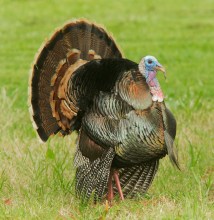
Cathartes aura
Year-round resident
Turkey vultures are scavengers — they use their keen eyesight and exceptional sense of smell to find carrion, the decaying flesh of dead animals. Their value in removing these potential disease sources from the environment is reflected in the genus name Cathartes, from the Greek word kathairein, meaning “to cleanse, purge.”
Appearance
Turkey vultures are large, dark birds, with silver linings along trailing half of wings, which looks like a wing-within-a-wing, and long tails. Adults have bare, red heads, while juveniles have gray heads.ID Tips
You can distinguish turkey vultures from other large soaring birds by their shallow V-shaped wings and by them “wobbling” from side-to-side — rarely flapping their wings.Turkey vultures get their name from the similarity to the reddish heads of male wild turkeys, which are also seen at Edgewood. Adult male wild turkeys are much larger and more colorful, have red waddles with blue and reddish heads, and weigh 11 to 23 pounds, while turkey vultures weigh up to 5 pounds.


At Edgewood
You can find turkey vultures any time of year, cruising on thermal drafts or updrafts from air colliding with trees in search of animal carcasses. Friends of Edgwood’s wildlife cameras demonstrate their keen sense of smell as turkey vultures detect a deer carcass hidden by a mountain lion under leaves and debris, beneath a woodland canopy.See iNaturalist, eBird, and Friends of Edgewood’s wildlife images for observations of this bird at Edgewood Park and Natural Preserve.
About
Turkey vultures have adaptations for success as a scavenger. Their impressive olfactory capability and keen eyesight allow them to locate dead animals quickly. Their sharp beak is suited for tearing into carcass flesh, and their featherless head ensures efficient eating without fouling feathers. Their digestive systems filter bacteria from decaying carcasses and tolerate pathogens that are toxic to many vertebrates.Their feet are somewhat akin to chicken’s feet, preventing turkey vultures from grabbing and killing their own prey efficiently. Instead, they rely on other animals to hunt.
Fun Facts
Turkey vultures hiss or grunt — they don’t sing or call like other birds, since they don’t have a syrinx, the vocal organ for birds.Turkey vultures poop their highly acidic feces onto their legs, which kills bacteria on their legs, and on carcasses, while reducing the bird’s body temperature through evaporative cooling.
Learn More
Learn more about turkey vultures on All About Birds.
Watch Creature Feature — Turkey Vulture.
Discover The Three P’s of Turkey Vultures.
References
Barrat, J. 2014, Nov. 25. Vultures Remarkably Tolerant To Deadly Bacteria, Study Reveals. Smithsonian Insider.
Barrat, J. 2017, Dec. 12. Scientists In Awe Of Huge Olfactory Bulb Found In Turkey Vulture Brain. Smithsonian Insider.
Belew, C. 2016. An Edgewood Bird Sampler. Friends of Edgewood Docent Manual.
Chattahoochee Nature Center. 15 Amazing Turkey Vulture Facts.
Cornell University. 2009, Apr. 1. Do Vultures Find Dead Animals by Smell or by Tracking Predators or Scavengers on the Ground? All About Birds.
Cornell University. 2019. Turkey Vultures. All About Birds.
Ely, T. 2019. Aug. 21. Project Zopilote. Golden Gate National Parks Conservancy.
Grigg, N.P. et al. 2017. Anatomical Evidence for Scent Guided Foraging in the Turkey Vulture. Scientific Reports 7: 17408.
Lindsay Wildlife Experience. 2021. Turkey Vulture.
Mallon, J.M., K.L. Bildstein, T.E. Katzner. 2016, Jan. 1. In-flight Turbulence Benefits Soaring Birds. The Auk 133: 79–85.
Merriam-Webster. 2021, Apr. 27. Cathartic. Merriam-Webster.com Dictionary.
Miskimen, M. 1957, Jan. 1. Absence of Syrinx in the Turkey Vulture (Cathartes aura). The Auk, 74: 104–105.
San Francisco Zoo. Turkey Vulture. WAAS Turkey Vulture Fact Sheet Grade 4.
